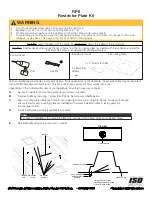
31792-4-1115
Page 18
DIRECT VENT AND COLINEAR VENT EXAMPLES
Max Vent Run - 40 ft. Equivalent With Three 90° Elbows
Special Note: The vent terminal 90° elbow and first 90° elbow
off back of the fireplace, when within six inches (15.2 cm),
do not contribute to the overall vent length measurement.
For each 45° elbow installed in the run, the length of the run
MUST be reduced by 1.5 feet (45 cm). Reduce the length of the
run three feet (91.4 cm) for every 90° elbow.
6’
5’
10’
10’
SINGLE FLUE ADAPTER
MODEL PVVK-FC
CO-LINEAR DIRECT VENT ADAPTER
MODEL PVCA
FIRST 90
DOES NOT GET COUNTED
WHEN WITHIN 6” (15.2cm)
OFF BACK OF HEATER
° ELBOW
90
° ELBOW
3 FEET
90
° ELBOW
3 FEET
CO-LINEAR TRANSITION
MODEL PVCT
OPTIONAL
VERTICAL TERMINATION CAP
MODEL PVVTC
PTRAP
H = 5’ + 6’ = 11’
V = 10’ + 10’ = 20’
(3) 90
° = 9’
TOTAL = 40’
SIDE VIEW
3” MIN.
12” MIN.
FLAT ROOF
3” MIN.
12” MIN.
EXHAUST
AIR INTAKE
EXHAUST
AIR INTAKE
SLOPE
SLOPE
Figure 14
Calculation example of vent run maximum 40 feet
Figure 14 displays a two-pipe installation. Because the distance
from the fireplace to the first elbow is more than six inches, the
length allowance for the first 90° elbow must be added to the total
vent length. The equivalent length of the second 90° elbow also
needs to be added to the total length. The third elbow also needs
to be included. The equivalent length of the PTrap does not need
to be added since it is the termination. The total horizontal vent
length of the flue system is eleven feet, and the total vertical length
is 20 feet. The three 90° elbows are equivalent to nine feet, bring
-
ing the total to 40 feet.
Note:
The exhaust must be a minimum of three inches above the
inlet air pipe. The flue must be at least twelve inches from the roof
line, and it is recommended to be at least twelve inches above the
maximum expected snow level as indicated in Figures 13 through
20.
Note:
On horizontal runs, a P.V.C. support clamp needs to be in
-
stalled every three feet. No “sags” in horizontal vent runs; water
will settle in the pipe.
When installing a colinear horizontal, the minimum vent length
protruding from the outside wall is six inches (15.2 cm) for air in
-
take and nine inches for exhaust. See Figure 15.
Note:
Horizontal discharge 90° elbow must be pointed downward.
See Figure 15. All horizontal runs require either a 1/4” per foot rise
to run condensation back to the fireplace, or a 1/4” per foot down
-
ward slope to run condensation away from the fireplace.
Note:
All PVC vent run piping can be purchased at a local hard
-
ware store. Schedule 40 PVC pipe should be used and cemented.
PVCA Horizontal Colinear Direct Vent Adaptor, PVVTC Cap, PV
-
VK-CFA Flex Kit and PVVK-SH Horizontal Vent Adaptor Kit are
available from Empire Comfort Systems, Inc.
In both vertical and horizontal colinear direct vent applications,
a colinear transition plate model PVCT can be used to minimize
clearances between intake and exhaust pipes.
For horizontal colinear direct venting, exhaust and intake air, cap
pipes with 90º elbows, pointed downward.
Note
: If transition plate (model PVCT) is used, the measurement
for center to center of the pipes will be 2.5”. If the transition plate
(model PVCT) is not used, the measurement for center to center
of the pipes can be 3” to 24” maximum.
9” MIN.
MIN. 2”
6” MIN.
3” MIN.
12" MIN TO GRADE
(RECOMMENDED 12"MIN.
TO MAX EXPECT SNOW LEVEL)
Figure 15
Note:
Exhaust must be a
minimum of 3 inches above
air intake inlet.
Содержание Mantis FG28BM-1
Страница 45: ...31792 4 1115 Page 45 Figure 67 Figure 68 Figure 69 Figure 70...
Страница 50: ...31792 4 1115 Page 50 APPLIANCE SERVICE HISTORY Date Dealer Name Service Technician Name Service Performed Notes...
Страница 51: ...31792 4 1115 Page 51 APPLIANCE SERVICE HISTORY Date Dealer Name Service Technician Name Service Performed Notes...
















































